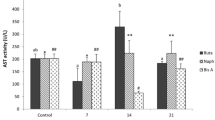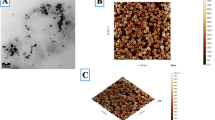Abstract
Despite favorable publicity of bioremediation as an affordable technology for cleanup of crude oil, public concerns on ecological safety in the presence of residual oil remain a global challenge. In this study, effects of crude oil exposure at sublethal concentration (0.25% v/v) and bioremediation treatment were investigated on histology and biochemical parameters of organs (gills, liver, kidney, and brain) of juvenile Nile tilapia (Oreochromis niloticus). Ten percent (10%) of mixed bacterial culture was used for bioaugmentation treatment. Ninety juvenile fish were used for study, and experiments were carried out in triplicates for three different groups. Malondialdehyde (MDA), an index of lipid peroxidation, was assayed as biomarker for oxidative stress. Activities of antioxidant enzymes (superoxide dismutase (SOD) and catalase (CAT)), level of non-enzymatic antioxidant (reduced glutathione (GSH)), and activity of brain acetylcholinesterase (AChE) were assayed in selected fish organs as markers for environmental stressor. Histological examination of fish organs was done for all groups. Results of treated groups were compared with those of the control. Levels of MDA significantly increased with significant inhibition of antioxidant enzyme activities in the polluted group. Activities of SOD, CAT, and AChE and levels of GSH in fish organs in the bioaugmentation group were similar to results obtained in the control. Remarkably, the bioaugmentation group showed minimal or no lesions which suggested the efficacy of bioremediation technique in alleviating crude oil toxicity and preserving normal physiology of fish. This study provides deeper insights into the ecosafety of bioremediation treatment and can be extrapolated to other species of fish.










Similar content being viewed by others
References
Abdel-Moneim AM, Essawy AE, El-Din NKB, El-Naggar NM (2016) Biochemical and histopathological changes in liver of the Nile tilapia from Egyptian polluted lakes. Toxicol Ind Health 32(3):457–467
Abdel-Tawwab M (2012) Chronic effect after acute exposure to commercial petroleum fuels on physiological status of Nile tilapia, Oreochromis niloticus (L.). Int. Aquatic Res 4:11
Afifi M, Alkaladi A, Zinada OAA, Couderchet M (2017) Alteration in antioxidant genes expression in some fish caught from Jeddah and Yanbu coast as a bio-indicator of oil hydrocarbons pollution. Saudi J Biol Sci 24(7):1580–1587
Almeida AR, Fatima J, Jorge FH, Thayre SA, Angela B, Olga K, Pham TG, Amadeu MVM, Soares MO, Ines D (2019) The role of humic acids on gemfibrozil toxicity to zebrafish embryos. Chemosphere 220:556–564
Almeida D, Almodvar A, Nicola GG, Elvira B (2008) Fluctuating asymmetry, abnormalities and parasitism as indicators of environmental stress in cultured stocks of goldfish and carp. J Aquac 279(1–4):120–125
American Public Health Association (APHA) (1998) Standard methods for the examination of water and wastewater, 20th edn. American Public Health Association, Washington DC
Armstrong T, Khursigara AJ, Killen SS, Fearnley H, Parsons KJ, Esbaugh AJ (2019) Oil exposure alters social group cohesion in fish. Sci Rep 9:13520
Azaza MS, Dhraïef MN, Kraïem MM (2008) Effects of water temperature on growth and sex ratio of juvenile Nile tilapia Oreochromis niloticus (Linnaeus) reared in geothermal waters in southern Tunisia. J Therm Biol 33(2):98–105
Awoyinka OA, Atulomah E, Atulomah NO (2011) Comparative effects of crude oil on juveniles Clarias gariepinus and Clarias anguillaris. Int J Fish Aquac 3(13):239–243
Benyahia F, Embaby AS (2016) Bioremediation of crude oil contaminated desert soil: effect of biostimulation, bioaugmentation and bioavailability in biopile treatment systems. Int J Environ Res Public Health 13:219
Beutler E, Duron O, Kelly BM (1963) Improved method for the determination of blood glutathione. J Lab Clin Med 61:882–890
Bradford MM (1976) A rapid and sensitive method for the quantitation of microgram quantities of protein utilizing the principle of protein-dye binding. Anal Biochem 72:248–254
Buege JA, Aust SD (1978) Microsomal lipid peroxidation. Methods Enzymol 52:302–310
Carpenter A (2019) Oil pollution in the North Sea: the impact of governance measures on oil pollution over several decades. Hydrobiologia 845:109–127
Elarabany N, Bahnasawy M (2019) Comparative and interactive biochemical effects of sub-lethal concentrations of cadmium and lead on some tissues of the African catfish. Toxicol Res 35:249–255
Ellman GL, Courtney KD, Adres V, Featherston RMA (1961) New and rapid colorimetric determination of AChE activity. Biochem Pharmacol 7(2):88–95
Farah MA, Ateeq B, Ali MN, Sabir R, Ahmad W (2004) Studies on lethal concentrations and toxicity stress of some xenobiotics on aquatic organisms. Chemosphere 55(2):257–265
Food and Agriculture Organization of the United Nations (2017) World Aquaculture 2015: a brief overview, by Rohana Subasinghe. FAO Fish Aquac Circ 1140:1–34
Frank O, Boisa N (2018) The effect of crude oil spill on the surface water of the lower Niger Delta (Sombriero River). J Ind Environ Chem 2(2):19–24
Freitas AP, Santos CR, Sarcinelli PN, Silva Filho MV, Hauser-Davis RA, Lopes RM (2016) Evaluation of a brain acetylcholinesterase extraction method and kinetic constants after methyl-paraoxon inhibition in three Brazilian fish species. PLoS One 11(9):e0163317
Gad NS (2011) Oxidative stress and antioxidant enzymes in Oreochromis niloticus as biomarkers of exposure to crude oil pollution. IJESE 1:49–58
Hegazi MM, Attia ZI, Ashour OA (2010) Oxidative stress and antioxidant enzymes in liver and white muscle of Nile tilapia juveniles in chronic ammonia exposure. Aquat Toxicol 99:118–125
Herrero M, Stuckey DC (2014) Bioaugmentation and its application in wastewater treatment: a review. Chemosphere 140:119–128
Howard DW, Lewis EJ, Keller BJ, Smith CS (2004) Histological techniques for marine bivalve mollusks and crustaceans. NOAA Tech Mem NCCOS 5:1–218
Ivshina IB, Kuyukina MS, Krivoruchko AV, Elkin AA, Makarov SO, Cunningham CJ, Peshkur TA, Atlas RM, Philp JC (2015) Oil spill problems and sustainable response strategies through new technologies. Environ Sci Process Impacts 17:1201–1219
Khursigara AJ, Ackerly KL, Esbaugh AJ (2019) Oil toxicity and implications for environmental tolerance in fish. Comp Biochem Physiol Part C Toxicol Pharmacol 220:52–60
Lari E, Abtahi B, Hashtroudi MS (2016) The effect of the water soluble fraction of crude oil on survival, physiology and behaviour of Caspian roach, Rutilus caspicus (Yakovlev, 1870). Aquat Toxicol 170:330–334
Lee CE, Remfert JL, Opgenorth T, Lee KM, Stanford E, Connolly JW, Kim J, Tomke S (2017) Evolutionary responses to crude oil from the Deepwater Horizon oil spill by the copepod Eurytemora affinis. Evol Appl 10:813–828
Lionetto M, Caricato R, Giordano M (2019) Pollution biomarkers in environmental and human biomonitoring. Open Biomark J 9:1–9
Luna LG (1968) Manual of histologic staining methods of the Armed Forces Institute of Pathology, 3rd edn. McGraw-Hill Book Company
Makori AJ, Abuom PO, Kapiyo R, Anyona DN, Dida GO (2017) Effects of water physico-chemical parameters on tilapia (Oreochromis niloticus) growth in earthen ponds in Teso North Sub-County, Busia County. Fish Aquatic Sci 20:30
Meador JP, Nahrgang J (2019) Characterizing crude oil toxicity to early-life stage fish based on a complex mixture: are we making unsupported assumptions? Environ Sci Technol 53(19):11080–11092
Murali M, Athif P, Suganthi P, Sadiq BA, Syed Mohamed HE, Basu H, Singhal RK (2018) Toxicological effect of Al2O3 nanoparticles on histoarchitecture of the freshwater fish Oreochromis mossambicus. Environ Toxicol Pharmacol 59:74–81
Mustapha MK, Atolagbe SD (2018) Tolerance level of different life stages of Nile tilapia Oreochromis niloticus (Linnaeus, 1758) to low pH and acidified waters. JoBAZ 79:46
Nivelle R, Gennotte V, Kalala EJK, Ngoc NB, Muller M, Mélard C, Rougeot C (2019) Temperature preference of Nile tilapia (Oreochromis niloticus) juveniles induces spontaneous sex reversal. PLoS One 14(2):e0212504
Ogunsuyi OI, Fadoju OM, Akanni OO, Alabi OA, Chibuisi G, Alimba CG, Cambier S, Eswara S, Gutleb AC, Adaramoye OA, Bakare AA (2019) Genetic and systemic toxicity induced by silver and copper oxide nanoparticles, and their mixture in Clarias gariepinus (Burchell, 1822). Environ Sci Pollut Res 26(26):27470–27481
Ojwala RA, Otachi EO, Kitaka NK (2018) Effect of water quality on the parasite assemblages infecting Nile tilapia in selected fish farms in Nakuru County, Kenya. Parasitol Res 117(11):3459–3471
Olajuyigbe FM, Ehiosun KI, Jaiyesimi KF (2015) Preliminary study towards enhanced crude oil biodegradation reveals congeneric total peroxidases with striking distinctions. Adv Enzyme Res 3:66–74
Olajuyigbe FM, Ojo OE (2017) Effect of bioaugmentation on crude oil contaminated pond water as revealed by oxidative stress in African catfish (Clarias gariepinus). J Sustain Technol 8(2):78–87
Omar-Ali A, Hohn C, Allen PJ, Rodriguez J, Petrie-Hanson L (2015) Tissue PAH, blood cell and tissue changes following exposure to water accumulated fractions of crude oil in alligator gar, Atractosteus spatula. Mar Environ Res 108:33–44
Oshienemen NA, Dilanthi A, Richard PH (2018) Evaluation of the impacts of oil spill disaster on communities and its influence on restiveness in Niger Delta, Nigeria. Procedia Eng 212:1054–1061
Ossana NA, Baudou FG, Castañé PM, Tripoli L, Soloneski S, Ferrari L (2019) Histological, genotoxic, and biochemical effects on Cnesterodon decemmaculatus (Jenyns 1842) (Cyprinodontiformes, Poeciliidae): early response bioassays to assess the impact of receiving waters. J Toxicol:4687685, 1–4687613
Plessl C, Otachi EO, Körner W, Avenant-Oldewage A, Jirsa F (2017) Fish as bioindicators for trace element pollution from two contrasting lakes in the Eastern Rift Valley, Kenya: spatial and temporal aspects. Environ Sci Pollut Res Int 24(24):19767–19776
Rahimikia E (2017) Analysis of antioxidants and serum biochemical responses in goldfish under nickel exposure by sub-chronic test. J Appl Anim Res 45(1):320–325. https://doi.org/10.1080/09712119.2016.1190732
Samarghandian S, Azimi-Nezhad M, Borji A, Samini M, Farkhondeh T (2017) Protective effects of carnosol against oxidative stress induced brain damage by chronic stress in rats. BMC Complement Altern Med 17:249
Santini SJ, Cordone V, Mijit M, Bignotti V, Aimola P, Dolo V, Falone S, Amicarelli F (2019) SIRT1-dependent upregulation of antiglycative defense in HUVECs is essential for resveratrol protection against high glucose stress. Antioxidants 8:346
Shishir TA, Mahbub N, Kamal NE (2019) Review on bioremediation: a tool to resurrect the polluted rivers. Pollution 5(3):555–568
Schofield PJ, Peterson MS, Lowe MR, Brown-Peterson NJ, Slack WT (2011) Survival, growth and reproduction of non-indigenous Nile tilapia, Oreochromis niloticus (Linnaeus 1758). I. Physiological capabilities in various temperatures and salinities. Mar Freshw Res 62:439–449
Sinha AK (1972) Colorimetric assay of CAT. Anal Biochem 47(2):389–394
Slaninova A, Smutna M, Modra H, Svobodova Z (2009) A review: oxidative stress in fish induced by pesticides. Neuro Endocrinol Lett 30(1):2–12
Stone N, Shelton JL, Haggard BE, Thomforde HK (2013) Interpretation of water analysis reports for fish culture. Southern Regional Aquaculture Center (SRAC) Publication No. 4606:12
Sun M, Zigman S (1978) An improved spectrophotometric assay for SOD based on epinephrine autoxidation. Anal Biochem 90(1):81–89
Syed MSN, Rehana S (2014) Determination of water quality parameters of water supply in different areas of Karachi City. Eur Acad Res 1(12):6031–6050
Thompson CM, Richardson RJ (2004) Anticholinesterase toxicology. In: Marrs TC, Ballantyne B (eds) Pesticide toxicology and international regulation. John Wiley & Sons Ltd, West Sussex, pp 89–127
Umar A, Modu BM, Abdullahi A, James T, Ahmed A, Abubakar U, Kucheli M, Harira G, Ibrahim I (2017) Studies on the toxicity of crude and refined oil on Nile tilapia (Oreochromis niloticus Linnaeus 1858). Niger J Fish Aquac 5(1):64–68
Zakia K, Muhammad AR, Farkhanda M, Saira R, Ghazala J, Shafaq F, Shahzad N (2019) A comparative assessment of nanotoxicity induced by metal (silver, nickel) and metal oxide (cobalt, chromium) nanoparticles in Labeo rohita. Nanomaterials 9(2):309
Funding
This study received financial support from the TETFund, Nigeria, through the Institutional Based Research Grant (IBR) 2015.
Author information
Authors and Affiliations
Corresponding author
Additional information
Responsible editor: Philippe Garrigues
Publisher’s note
Springer Nature remains neutral with regard to jurisdictional claims in published maps and institutional affiliations.
Rights and permissions
About this article
Cite this article
Olajuyigbe, F.M., Adeleye, O.A., Kolawole, A.O. et al. Bioremediation treatment improves water quality for Nile tilapia (Oreochromis niloticus) under crude oil pollution. Environ Sci Pollut Res 27, 25689–25702 (2020). https://doi.org/10.1007/s11356-020-09020-8
Received:
Accepted:
Published:
Issue Date:
DOI: https://doi.org/10.1007/s11356-020-09020-8




